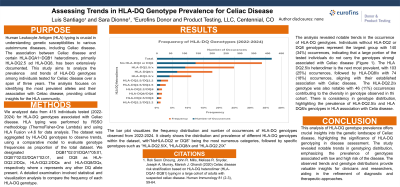Back

Assessing Trends in HLA-DQ Genotype Prevalence for Celiac Disease
(P421) Assessing trends in HLA-DQ genotype prevalence for celiac disease
Location: Platinum Ballroom

Poster Presenter(s)
Aim: This study aimed to analyze the prevalence and trends of HLA-DQ genotypes among individuals tested for Celiac disease over a span of three years. The analysis focuses on identifying the most prevalent alleles and their association with Celiac disease.
Method: We analyzed data from 415 individuals tested for HLA-DQ genotypes associated with Celiac disease. Typing was performed by RSSO methodology (ThermoFisher-One Lambda) and Fusion v.4.6 for data analysis. The dataset was aggregated by HLA-DQ genotypes to observe trends, using a comparative model to evaluate genotype frequencies as proportion of the total dataset. We designated DQB1*02:01/DQA1*05:01, DQB1*02:02/DQA1*02:01, and DQ8 as HLA-DQ2.2/DQx, HLA-DQ2.2/DQx and HLA-DQ8/DQx, respectively where x represents any other DQ allele present. A detailed examination involved statistical analysis to compare the frequency of each HLA-DQ genotype.
Results: The analysis revealed notable trends in the occurrences of HLA-DQ genotypes. Individuals without HLA-DQ2 or DQ8 genotypes represent the largest group with 140 (34%) occurrences, indicating that a large portion of the tested individuals do not carry the genotypes strongly associated with Celiac disease (Figure 1). The HLA-DQ2.5/x heterodimer is the next most prevalent, with 103 (25%) occurrences, followed by HLA-DQ8/x with 74 (18%) occurrences, aligning with their established association with Celiac disease. The HLA-DQ2.2/x genotype was also notable with 46 (11%) occurrences, contributing to the diversity in genotype observed in this cohort. There is consistency in genotype distribution, highlighting the prevalence of HLA-DQ2.5/x and HLA-DQ8/x genotypes in HLA association with Celia disease.
Conclusion: This analysis of HLA-DQ genotype prevalence offers insights into the genetic landscape of Celiac disease, highlighting the significance of HLA-DQ genotyping in disease assessment. The study revealed notable trends in genotyping distribution, emphasizing the prevalence of genotypes associated with low and high risk of the disease. By providing a broader understanding of genotype trends, this study contributes addition knowledge to HLA disease association testing for Celiac disease.
Method: We analyzed data from 415 individuals tested for HLA-DQ genotypes associated with Celiac disease. Typing was performed by RSSO methodology (ThermoFisher-One Lambda) and Fusion v.4.6 for data analysis. The dataset was aggregated by HLA-DQ genotypes to observe trends, using a comparative model to evaluate genotype frequencies as proportion of the total dataset. We designated DQB1*02:01/DQA1*05:01, DQB1*02:02/DQA1*02:01, and DQ8 as HLA-DQ2.2/DQx, HLA-DQ2.2/DQx and HLA-DQ8/DQx, respectively where x represents any other DQ allele present. A detailed examination involved statistical analysis to compare the frequency of each HLA-DQ genotype.
Results: The analysis revealed notable trends in the occurrences of HLA-DQ genotypes. Individuals without HLA-DQ2 or DQ8 genotypes represent the largest group with 140 (34%) occurrences, indicating that a large portion of the tested individuals do not carry the genotypes strongly associated with Celiac disease (Figure 1). The HLA-DQ2.5/x heterodimer is the next most prevalent, with 103 (25%) occurrences, followed by HLA-DQ8/x with 74 (18%) occurrences, aligning with their established association with Celiac disease. The HLA-DQ2.2/x genotype was also notable with 46 (11%) occurrences, contributing to the diversity in genotype observed in this cohort. There is consistency in genotype distribution, highlighting the prevalence of HLA-DQ2.5/x and HLA-DQ8/x genotypes in HLA association with Celia disease.
Conclusion: This analysis of HLA-DQ genotype prevalence offers insights into the genetic landscape of Celiac disease, highlighting the significance of HLA-DQ genotyping in disease assessment. The study revealed notable trends in genotyping distribution, emphasizing the prevalence of genotypes associated with low and high risk of the disease. By providing a broader understanding of genotype trends, this study contributes addition knowledge to HLA disease association testing for Celiac disease.

